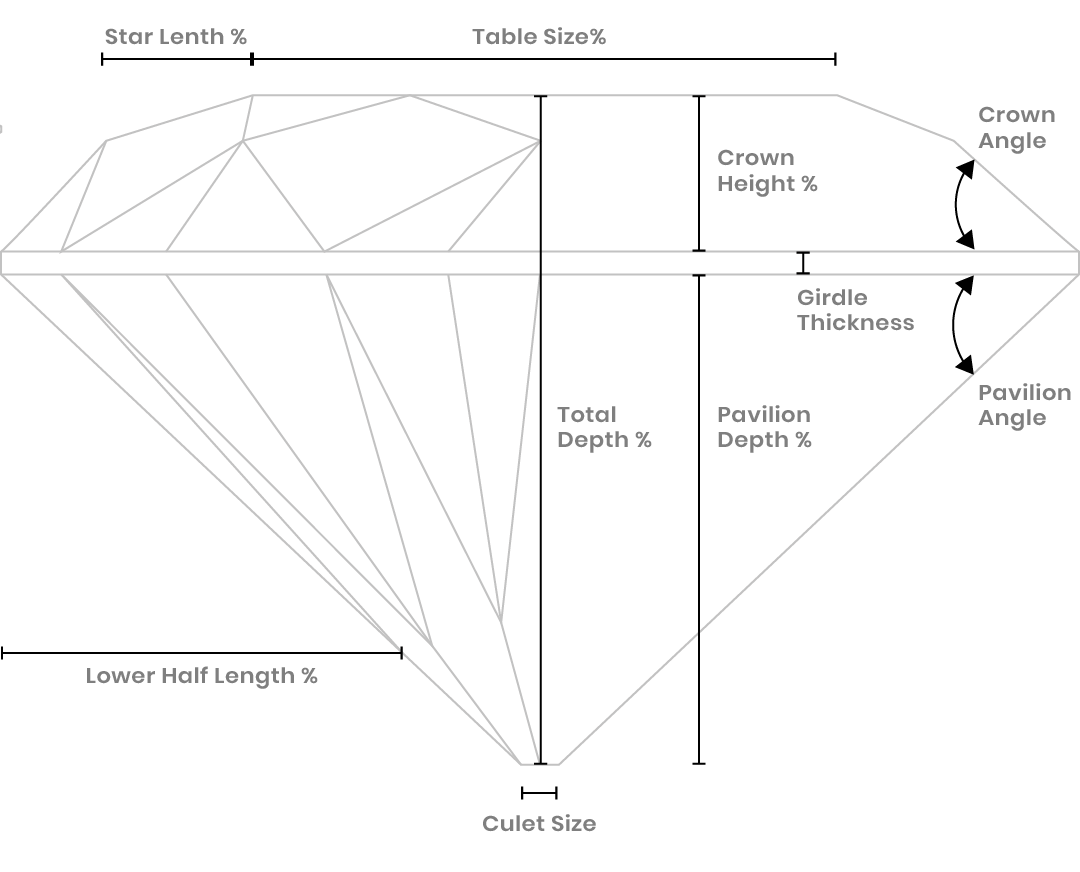Diamonds
The 4 C's | Diamond EducationDiamond Anatomy & Cut Quality
Cut quality is the factor that fuels a diamond’s fire, sparkle and brilliance. The allure and beauty of a particular diamond depends more on cut quality than anything else.
The GIA Diamond Cut Grading System for standard round brilliants in the D-to-Z color range is based on the assessment of seven components. The first three — brightness (the total light reflected from a diamond), fire (the dispersion of light into the colors of the spectrum), and scintillation (the pattern of light and dark areas and the flashes of light, or sparkle, when a diamond is moved) — are appearance-based aspects. The remaining four — weight ratio, durability, polish, and symmetry — are related to a diamond’s design and craftsmanship.
After a rough diamond is mined, it is evaluated to determine its best possible cut, in order to maintain the maximum clarity, color, and carat weight. People often use the words cut and shape interchangeably. They think of cut as the shape or outline of the diamond, rather than the arrangement of facets needed to create an attractive face-up appearance.
Round is the shape used in most diamond jewelry. All other outlines are known as fancy shapes. Examples of traditional fancy shapes include the marquise, pear and oval. Hearts, triangles and a variety of others are also gaining popularity in diamond jewelry.
Understanding the 4 C’s of Diamonds
Color, clarity, cut, and carat weight – the most important characteristics to understand when making a diamond purchase.
Color
Diamond color is all about what you can’t see. Diamonds are valued by how closely they approach colorlessness – the less color, the higher their value. (The exception to this is fancy color diamonds, such as pinks and blues, which lie outside this color range.) Most diamonds found in jewelry stores run from colorless to near-colorless, with slight hints of yellow or brown.
GIA’s color-grading scale for diamonds is the industry standard. The scale begins with the letter D, representing colorless, and continues with increasing presence of color to the letter Z, or light yellow or brown. Each letter grade has a clearly defined range of color appearance. Diamonds are color-graded by comparing them to stones of known color under controlled lighting and precise viewing conditions.
Many of these color distinctions are so subtle as to be invisible to the untrained eye. But these slight differences make a very big difference in diamond quality and price.



Clarity
Because diamonds formed deep within the earth, under extreme heat and pressure, they often contain unique birthmarks, either internal (inclusions) or external (blemishes).
Diamond clarity refers to the absence of these inclusions and blemishes. Diamonds without these birthmarks are rare, and rarity affects a diamond’s value. Using the GIA International Diamond Grading System™, diamonds are assigned a clarity grade that ranges from flawless (FL) to diamonds with obvious inclusions (I3).
Every diamond is unique. None is absolutely perfect under 10× magnification, though some come close. Known as Flawless diamonds, these are exceptionally rare. Most jewelers have never even seen one.
The GIA Clarity Scale contains 11 grades, with most diamonds falling into the VS (very slightly included) or SI (slightly included) categories. In determining a clarity grade, the GIA system considers the size, nature, position, color or relief, and quantity of clarity characteristics visible under 10× magnification.
- Flawless (FL) – No inclusions or blemishes are visible to a skilled grader using 10× magnification
- Internally Flawless (IF) – No inclusions and only blemishes are visible to a skilled grader using 10× magnification
- Very, Very Slightly Included (VVS1 and VVS2) – Inclusions are difficult for a skilled grader to see under 10× magnification
- Very Slightly Included (VS1 and VS2) – Inclusions are minor and range from difficult to somewhat easy for a skilled grader to see under 10x magnification
- Slightly Included (SI1 and SI2) – Inclusions are noticeable to a skilled grader under 10x magnification
- Included (I1, I2, and I3) – Inclusions are obvious under 10× magnification and may affect transparency and brilliance




Cut
People often use the words cut and shape interchangeably. They think of cut as the shape or outline of the diamond, rather than the arrangement of facets needed to create an attractive face-up appearance.
Round is the shape used in most diamond jewelry. All other outlines are known as fancy shapes. Examples of traditional fancy shapes include the marquise, pear and oval. Hearts, triangles and a variety of others are also gaining popularity in diamond jewelry.
While it is important to consider many components when assessing the overall cut appearance and quality of round brilliant diamonds, an individual’s preferences also play a role. Because each cut grade represents a wide range of proportion sets, individuals have the freedom to choose which particular appearance they prefer within the grade range.




Carat (Weight)
Diamonds and other gemstones are weighed in metric carats: one carat is equal to 0.2 grams, about the same weight as a paperclip. (Don’t confuse carat with karat, as in “18K gold,” which refers to gold purity.)
Just as a dollar is divided into 100 pennies, a carat is divided into 100 points. For example, a 50-point diamond weighs 0.50 carats. But two diamonds of equal weight can have very different values depending on the other members of the Four C’s: clarity, color and cut. The majority of diamonds used in fine jewelry weigh one carat or less.
Because even a fraction of a carat can make a considerable difference in cost, precision is crucial. In the diamond industry, weight is often measured to the hundred thousandths of a carat, and rounded to a hundredth of a carat. Diamond weights greater than one carat are expressed in carats and decimals. (For instance, a 1.08 ct. stone would be described as “one point oh eight carats,” or “one oh eight.”)

